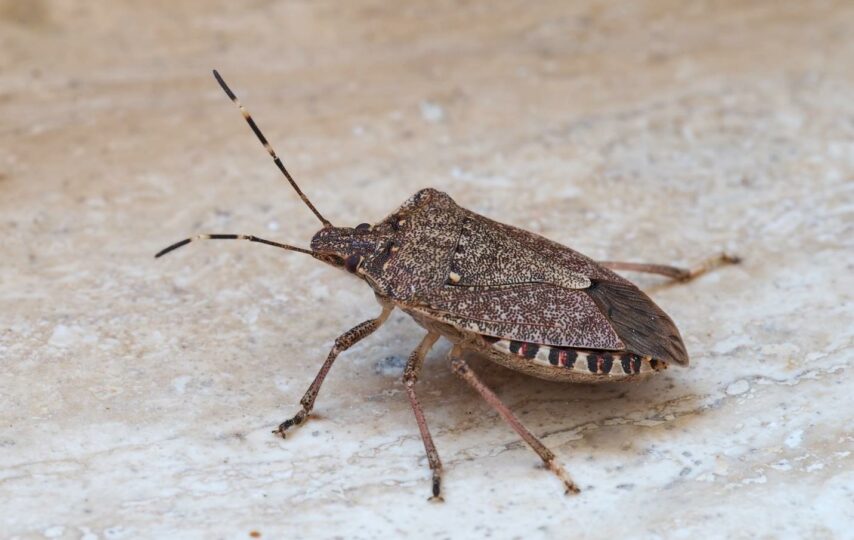Stink bugs are great threats to gardens. These creatures consume almost all types of crops including tomatoes, peppers, butter beans, and sweet corn among others. Besides the fruits like apples, peaches, pears, and grapes, stink bugs also ruin decorative plants such as roses, wood, etc. If you need to manage them, the following guide will assist you to keep stink bugs away from your garden using stink bug traps.
Stink bug trap: What You Need to Know
Stink bugs, also recognized as shield bugs, are invasive flying insects that made their way to the United States in the 1990s. These pests inflict damage on fruits and vegetables by puncturing the skins, causing them to brown from the inside out and ultimately perish. Emitting a noxious odor is their defense mechanism, triggered when they are handled or disturbed. Descriptions of the odor vary, with some likening it to cilantro, while others associate it with a smelly foot odor. While stink bugs are primarily a concern outdoors, their presence indoors can be disconcerting. It’s important to note, however, that they do not breed indoors or cause damage to the interior.
There’s no need for concern about stink bugs posing harm to humans. However, they can find their way into homes through cracks or gaps in the foundation and may accumulate in significant numbers in blinds, draperies, and light systems. The most effective approach is to prevent their entry from the outside, ensuring they don’t access the warmth of your home. To identify them, look for bugs with shield-shaped bodies in a grayish-brown hue. Adult stink bugs measure 1/2 inch in length, featuring dark antennae and distinctive white markings. Younger bugs are typically more rounded and may display green or black coloring.
3 Best Options for Stink Bug Traps
While store-bought pesticides are successful in eradicating numerous typical pests, they may not be as effective against a stink bug infestation. The most efficient approach to eliminating stink bugs involves employing preventive measures and utilizing traps to manage their populations.
Buy a Sticky Stink Bug Trap
Glue traps can be highly effective in capturing insects within your home. These traps come ready to use, allowing for convenient placement in areas where you see stink bugs. The adhesive residue effectively immobilizes the bugs until you’re ready to dispose of the trap. Additionally, you might even capture other bothersome insects when using these traps!
Create a Bottle Trap
For those with a creative inclination, crafting your trap is an option. To do this, acquire an empty soda bottle, choosing either a larger 2-liter bottle or a smaller 16-oz option based on the number of stink bugs you aim to trap. Cut off the top of the bottle and invert it, directing the opening toward the bottom. Securely tape this inverted top to the sides of the bottle to prevent it from coming undone.
When you come across a stink bug, gently guide it into the bottle to trap it inside, eliminating the need to touch these pests to remove them from your home. If you’re aiming to trap multiple bugs simultaneously, consider inserting an LED light into the bottle and leaving the trap out overnight. Stink bugs are attracted to the light and will enter the bottle. As they attempt to climb the interior of the bottle, they will fall back down, enhancing the trap’s effectiveness.
Utilize a Disposable Pan
Similar to the previous method, incorporate a light source in this approach as well. Obtain a disposable aluminum pan and fill it with water. If you’re uncertain about which pan to use, look for disposable foil pans available in the cooking aisle. Add dish soap to the pan and blend it with the water. The specific type of soap is not crucial, and you can use your favorite. Once everything is thoroughly mixed, illuminate the pan from within.
The stink bugs will reach for the light reflecting off the pan and will succumb to drowning in the soapy liquid. If stink bugs are causing trouble in your garden, this water and soap mixture can effectively eliminate them. Transfer the solution to a spray bottle and mist any stink bugs on your crops or within your home.
Conclusion
Combating stink bug infestations requires effective and practical solutions, and choosing the right trap can make a significant difference. Whether opting for store-bought glue traps, crafting a DIY trap from a soda bottle, or utilizing a water and soap-filled pan with a light source, each method offers a unique approach to address the challenge. By implementing these strategies, you can efficiently manage stink bug populations without resorting to harmful chemicals or invasive measures.
Selecting the best trap for your situation ensures a more pest-free and comfortable living environment. Experimenting with these options allows you to find the most suitable and effective solution for your stink bug woes, bringing relief to both your home and garden.
FAQs
Q1: Do stink bugs pose any harm to humans?
A: Stink bugs themselves do not harm humans, but they can be a nuisance. Their defensive mechanism releases a foul odor when disturbed.
Q2: Are store-bought pesticides effective against stink bugs?
A: Store-bought pesticides may not be as effective against stink bugs. The article recommends traps for better control.
Q3: How do glue traps work for stink bugs?
A: Glue traps are ready to use and you can place them in areas where you have observed stink bugs. The sticky residue immobilizes the bugs until the trap is disposed of.
Q4: Can I create my stink bug trap?
A: Yes, crafting a DIY trap using an empty soda bottle is an option. The article suggests cutting off the top and inverting it to trap stink bugs effectively.








